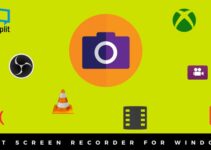Slideshow presentations may be made, edited, and shared with ease using the best presentation software.
Because presentation software is so integral to running, managing, and growing a business, this is quite significant. In a department, clear and concise communication of ideas, concepts, procedures, and workflows is often crucial.
Top Some Presentation Software:
However, while presentation software was once only able to operate with text and graphics, it has since expanded to include support for other media types, such as video and audio.

So that presentations can be more alive and effective in educating and informing their intended audience, the finest presentation software should be able to support these additional media in addition to being easy and simple to use.
The variety of available presentation software systems might be overwhelming. Because of this, we have compiled a list of the top presentation programmes available today, including both commercial and open-source options, as well as both free and paid versions.
Read Also:
1: PowerPoint
Microsoft’s PowerPoint is still widely regarded as the industry standard for presentation software. While there are now competitive solutions available, most people still prefer PowerPoint due to its widespread availability and user-friendly interface.
On the one hand, Microsoft PowerPoint has been included in the widely used Microsoft Office suite for many years, making it the default and final presentation programme for the vast majority of users.
It is even more difficult to avoid PowerPoint and other Microsoft office applications now that they are available as free apps (with limited capability) on iOS and Android for mobile use. The fact that PowerPoint is included in Microsoft’s cloud-based Office 365 service is a bonus.
It’s fully capable of performing all the duties required by presentation software, such as allowing you to add text and media to a sequence of slides to supplement a talk or other presentation. Even a user with no prior familiarity with PowerPoint should have no issue getting up and running because to the program’s intuitive interface and pre-made slides.
2: CustomShow
A company’s branding, from its logo to its typeface, speaks volumes about its values and mission. The business presentation software CustomShow prioritises these aspects of brand identity in its design.
You can use the system to make presentations that are unique to your firm and its products, complete with a branded logo and bespoke typefaces. There are also slide templates and analytics to help you fine-tune your presentations.
Presentations can also be imported into the software and edited there. All of your presentations are stored in the cloud and can be accessed from any computer, tablet, or smartphone. Companies like HBO and CBS Interactive employ this service because of its value in boosting brand awareness among consumers.
3: ClearSlide
ClearSlide, like CustomShow, is a specialised business presentation tool. The platform is targeted at organisations aiming to produce successful marketing campaigns, driving sales via presentations (and more), not least through a range of analytics and data to work for sales and marketing.
Document formats such as PPT, Keynote, PDF, and Excel are all supported by the programme. In addition to Google Drive and Dropbox, ClearSlide also works with Salesforce.
While the system’s complexity and abundance of extra capabilities may be overkill for certain organisations, the ability to generate unique content that conveys your brand’s message to clients is worth the learning curve. You may join up for a free trial before making any commitments, and there are some useful analytics and analytical features.
4: Haiku Deck
You can customise your slides in any presentation programme, but Haiku Deck takes it to the next level. In addition to a plethora of customizable templates, users also gain access to the Creative Commons’ vast image library of 40 million public domain pictures.
While making a presentation, you have the option of doing so online, which makes it viewable on a wide variety of mobile devices in addition to desktop computers. You may customise your presentation to perfection by choosing from a wide range of fonts, layouts, and filters, regardless of the device you’re using.
The beautiful thing about these adaptability choices is that they are separated out by market and application type. You can find topics related to education, food, real estate, and even new businesses. Most of the functions only work while you’re connected to the internet, so you’ll need a reliable connection wherever you go.
5: SlideDog
It is simple to deliver a boring presentation, and you definitely don’t want your audience to nod off. By allowing you to integrate nearly any media format, SlideDog helps you avoid the “cookie cutter” style that can make presentations seem boring to the audience.
It’s marketed as a web-based multimedia presentation tool, and it can merge things like PowerPoint slides, graphics, PDF files, Prezi presentations, web pages, photographs, videos, and movie clips. They can be easily presented to an audience by dragging them into individualised playlists.
Slideshows and playlists can be managed from afar via a mobile device, the web, or a second computer, and real-time slide sharing is also possible. If you provide a link, members of the audience can watch your slide directly on their own devices. You can use that function to your advantage if you want to make your presentation more engaging for your audience.
Of the presented presentation tools, SlideDog’s free account provides all the bare-bones functionality and is likely the most cost-effective option. Upgrading is required, though, if you want to take advantage of live streaming and premium customer service.
Details About the Presentation Software:
What is Presentation Software?
Presentation software is a type of application used to create slideshows that can include text, images, videos, and other multimedia elements. These slideshows are designed to aid in conveying information in a visually engaging format, often used in business meetings, academic lectures, and professional conferences.
Historical Perspective
The origin of presentation software can be traced back to the late 20th century, with the advent of personal computers. Over time, these programs have evolved from basic slide creation tools to sophisticated platforms offering a wide array of multimedia integration and interactive features.
Key Features of Presentation Software
1. Slide Creation and Layout
Allows users to create and organize slides with various layout options, customizable templates, and design elements.
2. Multimedia Integration
Enables the inclusion of various media types such as images, videos, charts, and audio clips to enhance the presentation’s appeal.
3. Animation and Transitions
Offers a range of animation effects and slide transition options to create a dynamic flow within the presentation.
4. Collaboration and Sharing
Many modern presentation tools support real-time collaboration, allowing multiple users to work on a presentation simultaneously and share it easily.
5. Interactive Elements
Some software includes features like polls, quizzes, and interactive diagrams to engage the audience and encourage participation.
6. Presenter Tools
Includes features like speaker notes, timers, and audience Q&A management to assist presenters during their presentation.
Benefits of Using Presentation Software
1. Enhanced Communication
Helps in clearly and effectively conveying complex ideas through visual aids, making information more accessible and understandable.
2. Professionalism and Branding
Enables the creation of polished and professional-looking presentations that can align with brand identity through customizable design elements.
3. Engaging and Interactive Presentations
With multimedia and interactive features, presentations become more engaging, increasing audience attention and participation.
4. Flexibility and Accessibility
Most presentation software offers cloud-based options, providing flexibility to access and edit presentations from anywhere.
Types of Presentation Software
1. Desktop-Based Solutions
These are installed on a computer and often offer a full range of features, suitable for creating complex and detailed presentations.
2. Web-Based Solutions
Cloud-based presentation tools that allow for online creation and collaboration, providing convenience and accessibility.
3. Mobile Applications
Apps that enable the creation and editing of presentations on mobile devices, useful for on-the-go adjustments and presentations.
Choosing the Right Presentation Software
1. Assess Your Requirements
Determine your specific needs, such as the level of complexity, collaboration features, or specific multimedia integration capabilities.
2. Consider User-Friendliness
Opt for software with an intuitive interface, especially if you are not an experienced designer or if quick turnaround is essential.
3. Compatibility and Integration
Ensure the software is compatible with your devices and can integrate seamlessly with other tools you use.
4. Evaluate Cost
Consider the software’s cost, especially if you need advanced features that are often available in paid versions.
5. Explore Customization Options
Look for software that offers extensive customization options to tailor your presentations to specific audiences or branding requirements.
6. Read Reviews and Seek Recommendations
Check out user reviews and seek recommendations from colleagues to understand the software’s effectiveness and reliability.
Implementing Presentation Software
1. Learning and Experimentation
Invest time in learning the software’s features and experiment with different design elements to create effective presentations.
2. Stay Updated
Keep abreast of new features and updates to the software to continually enhance your presentations.
3. Gather Feedback
After your presentations, gather feedback to understand what works well and what can be improved for future presentations.
Read Also:
Conclusion
Presentation software is a crucial tool in today’s professional and educational landscapes, enabling users to create compelling, informative, and visually appealing presentations. By understanding and utilizing the right presentation software, you can significantly enhance your ability to communicate complex ideas effectively.
As technology continues to advance, so too will the capabilities of presentation software, providing even more innovative ways to engage audiences and deliver impactful presentations.


